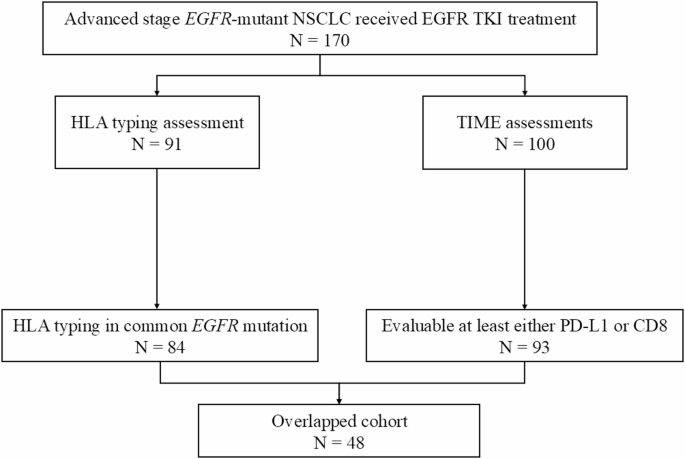Study participants
We conducted a prospective cohort at The King Chulalongkorn Memorial Hospital in Bangkok, Thailand. The study included participants aged ≥ 18 years diagnosed with EGFR-mutated recurrence or advanced-stage NSCLC. EGFR mutation testing was conducted using single gene testing Cobas® mutation test v2. or diver alteration gene panel. All participants received EGFR TKIs (1st -3rd generation) as first-line treatment, according to the provided physician. The pretreatment assessment and response evaluation were conducted as a standard practice of the institute. Demographic characteristics were obtained from the hospital’s electronic medical records. I confirm that all experiments were performed in accordance with the Declaration of Helsinki. The Institutional Review Board of the Faculty of Medicine, Chulalongkorn University, Bangkok, Thailand, approved the study. (IRB No. 894/63 and 580/66). Written informed consent was obtained from all participants. The Bureau of Registration Administration, Ministry of Interior, Bangkok, Thailand, validated the participant’s death date.
Tumor immune microenvironment assessment
Tissue samples were collected upon the diagnosis of advanced-stage non-small cell lung cancer. CD8 Tumor-infiltrating lymphocytes (TILs) and PD-L1 were evaluated by immunohistochemistry. The interpretation was made by one pathologist (S.S.) who was blinded to clinical outcomes. TILs were assessed using immunohistochemistry staining to evaluate the expression of CD8 + T-cells according to the guidelines established by the International TILs Working Group in 2014 17. The evaluation was based on the spatial location of CD8 + TILs, intra-tumoral or stromal. Intra-tumoral CD8 + TILs were defined as CD8 + TILs with direct cell-cell contact with carcinoma cells. The results will be presented as percentages based on tumor cells17. High intra-tumoral CD8 + TILs were defined as intra-tumoral CD8 + TILs ≥ 10%18. PD-L1 was assessed using the Dako FLEX 22C3 and presented by the tumor proportion score19,20. High PD-L1 was defined as PD-L1 TPS ≥ 15% as previously demonstrated the correlation with prognosis21. The definition of inflammatory tumor microenvironment was defined as either PD-L1 TPS ≥ 15% or intra-tumoral CD8 + TILs ≥ 10% as previously reported4,18,21,22.
Blood specimen correction and HLA typing evaluation
Blood samples were collected before the participants started EGFR TKIs treatment in an EDTA tube, centrifuged, and kept at -80 °C until further process. The evaluation of HLA typing was performed by buffy coat using whole-exome sequencing technology. Briefly, DNA from the buffy coat was extracted using a Qiagen blood mini kit following manufacturer protocol. Library preparation was proceeded using SureSelectXT V6 + UTR library prep kit (Illumina, San Diego, CA, USA). The sequencing was conducted using NovoSeq to generate 150 bp paired-end reads at Macrogen Inc. (Seoul, Korea). We analyzed data through bcbio-nextgen version v1.2.923 with target sequences of approximately 90 Mb. Unmapped BAM was generated from Fastq raw data, aligned with hg38 reference using BWA version 0.7.1724, and processed by using the GATK best practice pipeline through Genome Analysis Toolkit recommendation (GATK version 4.1.0.0 including MarkDuplicates, base quality score recalibration, indel realignment, duplicated removal. We identify high polymorphic HLAs using OptiType algorithm25 which shown high accuracy26. The HLA-A was classified into interested and non-interested subtypes based on the binding affinity of the EGFR mutation subtype, which had been previously reported15. The higher binding affinity of the HLA-A subtype represented potential neoantigen. The interested HLA-A was also correlated with favorable prognostic outcomes in resectable NSCLC15. For EGFR L858R alteration, interested HLA-A subtypes were HLA-A*30:01, HLA-A*31:01, HLA-A*33:01, HLA-A*33:03, HLA-A*34:01, HLA-A*66:02, HLA-A*68:01, HLA-A*68:03, HLA-A*68:04, and HLA-A*68:05. While EGFR exon 19 deletion, interested HLA-A subtypes were HLA-A*03:01, HLA-A*03:02, HLA-A*11:01, HLA-A*30:01, HLA-A*34:02, HLA-A*68:01. The presence of one allele of interested HLA-A was considered positive for interested HLA-A.
Sample size calculation
The author was calculated based on Dimou A., et al., who reported that the interesting HLA-A alleles, i.e., HLA-A*11:01, HLA-A*24:02, HLA-A*02:03, HLA-A*33:03, and HLA-A*02:07, exhibited greater binding efficacy to either EGFR L858R or exon 19 deletion peptides. The prevalence of HLA-A*11:01, HLA-A*24:02, HLA-A*02:03, HLA-A*33:03, and HLA-A*02:07 of the Thai population was 26%, 11%, 11%, 11%, and 8%, respectively as previously reported by Satapornpong et al.16. The prevalence of the inflammatory TIME reported by Matsumoto et al. was 13.5%4. We proposed a hypothesis that an interested HLA-A results in a four-fold higher frequency of inflamed TIME compared to uninterested HLA-A subtypes. Using a proportion sample size calculation27to achieve a Type 1 error rate of 5% and a power of 80%, the sample size was calculated to be 74, without continuity correction.
Statistical analysis
Categorical data was analyzed using the Chi-square or Fisher exact test. Continuous data was analyzed using the Mann-Whitney test. The correlation between the HLA-A and either inflammatory TIME or intra-tumoral CD8 TILs was calculated using the Chi-square test. Progression-free survival (PFS) was defined by the time of initiation EGFR-TKIs treatment to the date of objective disease progression or death from any cause. Overall survival (OS) was determined by the time of initiation of EGFR-TKIs treatment to the date of death from any cause. The data was censored on December 31, 2023, for alive or non-progressive disease participants. Multivariate analyses of clinical factors, HLA-A subtype, and tumor immune microenvironment expression level were performed using a Cox proportional hazards model. The Kaplan-Meier method was used to evaluate survival, and the log-rank test was used to evaluate the significance of the difference between groups. The significance level was defined as p-value < 0.05. Statistical analysis was performed using SPSS version 29.0.
